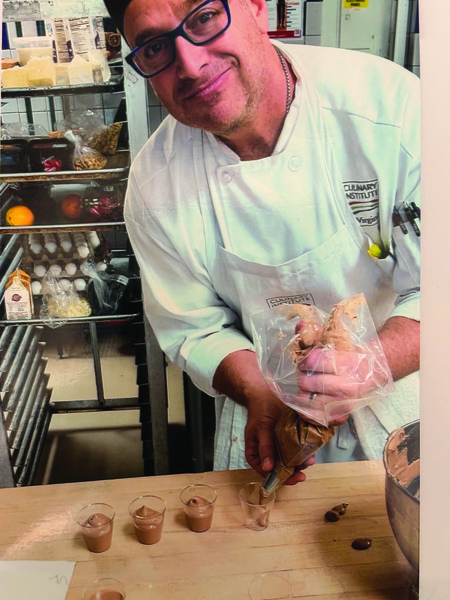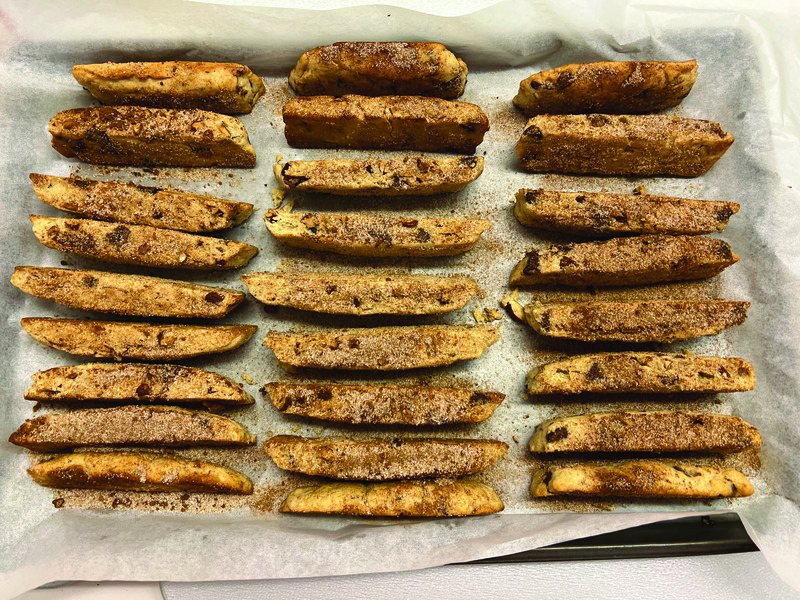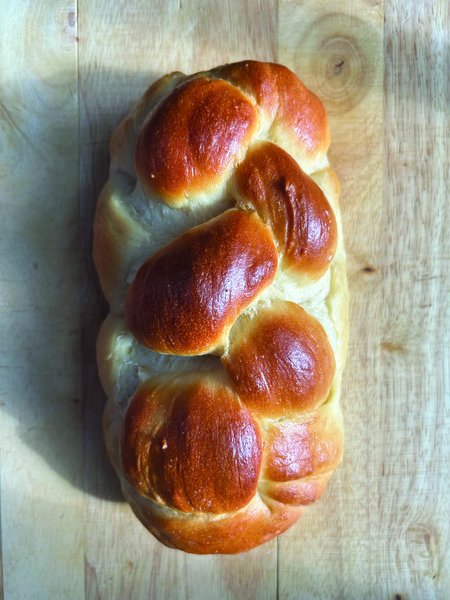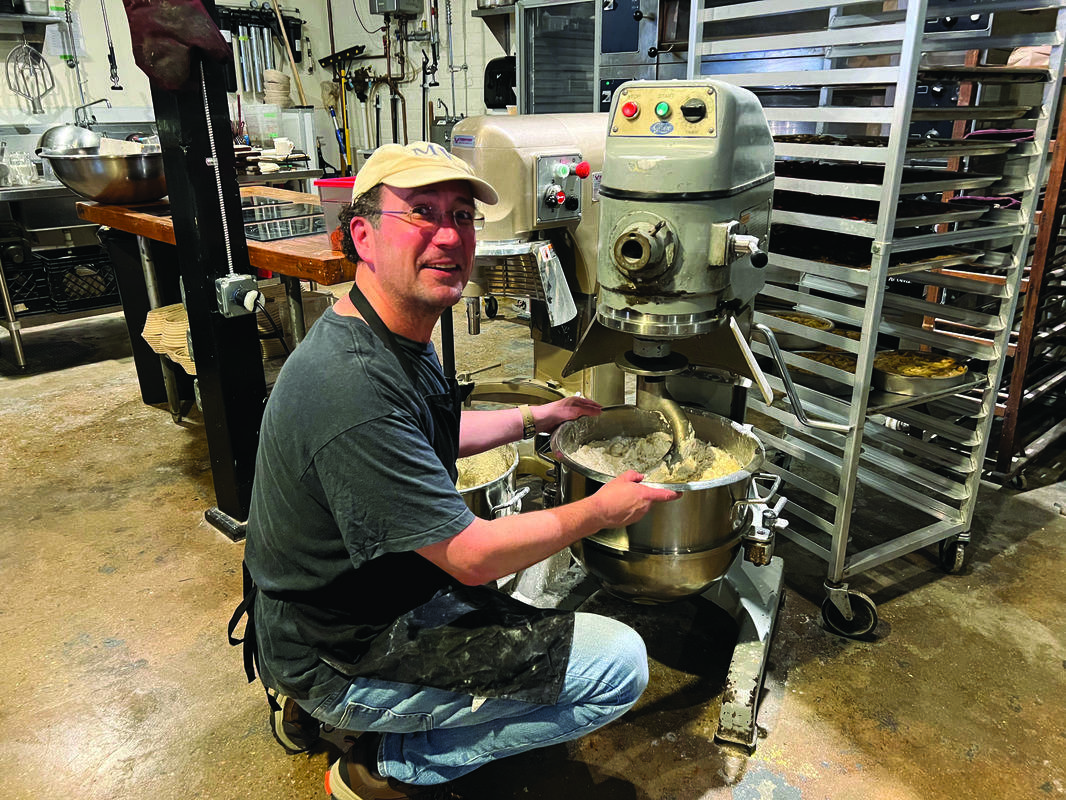Baking is a science that requires the precise chemistry of all ingredients. One misstep and a decadent dessert devolves into a tragic mess, a puffy souffle deflates into a cavernous hollow, or a delicate confection becomes a misshapen blob. ❦ David Leon, Joel Nied, and Scott Rosenblum have each perfected their art of baking through trial and error. For Jewish News, they share when they became bakers and how the hobby brings them joy.
David Leon
President of United Federation of Tidewater and a past president of Strelitz International Academy, David Leon is a Portsmouth native who once owned a trash hauling business.
Jewish News: How long have you been a baker?
David Leon: Five years.
JN: What prompted you to start baking?
DL: I’ve always cooked a lot and wanted to learn how to bake but was afraid to try. When the pandemic started, I asked Tami Arnowitz for her challah recipe and any pointers. She invited me to a zoom challah class at her new synagogue in Westchester, N.Y. I enjoyed it and realized it wasn’t as scary or difficult as I had imagined.
From there, I tweaked and modified her recipe as I learned new things and taught myself other recipes I found online.
JN: You work in the baking industry. How is it different from baking at home for yourself?
DL: As friends and family ate my creations, many suggested that I sell my challahs or start a bakery. Having had my own business before, I knew this was something I didn’t want to do.
Alvin Wall suggested I work at a bakery/restaurant next door to where he and his wife, Nancy, do pottery. About two and a half years ago, I started working at Prosperity Kitchen & Pantry a few hours a week for fun. I don’t really bake much there – mostly I do prep work and make various prepared foods. But I’ve learned new recipes and skills. The serving sizes are much larger, and I use large commercial equipment which I enjoy.
They have an open kitchen so it’s funny to see the reaction of people I know when they see me working there most Thursday afternoons. I’ve had to use much self-control not to eat the extra food which is always available and hidden from view from the customers.
JN: How often do you bake? Do you share your baked goods?
DL: I mostly bake challah, which I do for Shabbats when my girls are with me. I like that I’m creating Jewish food memories for my girls.
I also like the reaction from sharing with friends and family. I’ve made challahs for my niece and nephew’s weddings and for our family Rosh Hashanah luncheons and other gatherings.
If I’m invited to a Shabbos dinner, I will usually bring one of my challahs. I sometimes think this is the only reason I’m invited! For family Hanukkah gifts, I frequently bake cinnamon babka or Mandel bread. And for Pesach, I like to make my own matzah. Now I understand why many people give away baked goods.
JN: What is your favorite thing to bake?
DL: Challah is my favorite and most frequent thing to bake. But I also enjoy making cinnamon babka, Mandel bread and soft pretzels. I’ve made bagels a few times but they’re a lot of work.
JN: Do you have a favorite recipe you’d like to share with Jewish News?
DL: It’s funny how some people are so secretive with their recipes. I’ve found that most recipes are very similar, and I don’t mind sharing mine. (below)
Joel Nied
Originally from Jacksonville, Florida, Joel Nied is a partner at the law firm Price Benowitz LLP. He serves as president of the Virginia chapter of Friends of the Israel Defense Forces (FIDF) and as a board member of Beth Sholom Home and Tidewater Jewish Foundation, among others.
Jewish News: When did you start baking?
Joel Nied: I’ve cooked since college, but the baking began in earnest probably around 2016.
Jewish News: Did someone or something inspire you to bake?
JN: I read somewhere that one of the best ways to instill a sense of the importance of Judaism in your kids is to light candles every Friday night. And what better way to get them to look forward to it than offering some freshly made challah?
I sought out a recipe that was low effort, as opposed to one that looked or tasted perfect, with the idea that if it was easy to make, I would do it more often. As it turned out, I managed to come up with a recipe that is easy to make and tastes and looks fantastic. As a result, I’ve made it pretty much every Friday for the past seven to eight years. Family and other people who have had it, love it. I bring it to neighborhood happy hours and the neighbors love it (even though they don’t know what it is) and I send them to my son in college. It’s a big hit and easy to make. Everyone should do it. Don’t strive for perfection. Just do it.
Jewish News: How often do you bake?
JN: Pretty much every Friday for challah. But I realized quickly that baking (and food in general) was a great way to introduce my kids to the broad spectrum of Jewish traditions and our collective heritage. As a result, I look out for food from everywhere. We regularly make fazuelos for Purim (OK, technically not baking, but it involves dough), strawberry jelly and chocolate sufganiyot for Hanukkah and, whenever we’re in the mood, khachapuri and, of course, babka.
Jewish News: What is your favorite thing to bake?
JN: Khachapuri is something the family goes crazy over whenever we make it. But the crowning achievement is babka. I am not exaggerating when I say our babka is possibly the best on the East Coast. Maybe the country. That’s not just me. It’s so good that someone consumed one so quickly, it almost killed him; he sucked it into his lungs and had to go to the hospital.
I’ve taught Simone, my daughter, the recipe and technique and she can replicate my results. Please don’t ask whether it’s chocolate babka. That’s like asking whether a martini is a gin martini. Of course it’s chocolate. Simone, however, did come up with a babka where one helix is cream cheese frosting and the other is a pecan/cinnamon filling. It’s awesome. We bake other things (like a confection we call “Cakepocalypse”), but there’s no connection to Judaism, other than the fact that we make it.

Scott Rosenblum
Baking is not just a hobby for Scott Rosenblum, who is retired from pediatric dentistry. A recent graduate of Culinary Institute of Virginia, this Tidewater native now works as a full-time chef. He’s worked at Inn by the Sea in Portland, Maine, Primo in Rockland, Maine, The Surf Club in Miami, and Chef and the Farmer in Kinston, N.C. In Virginia Beach, Rosenblum’s kitchens include TuLu, Eurasia, and Yorkie’s.
Jewish News: How long have you been a baker?
Scott Rosenblum: I took my first Baking & Pastry class in 2022 as part of the curriculum in culinary school.
JN: You have worked in prestigious restaurants. How is baking in a professional environment different from baking at home?
SR: Baking in a professional kitchen is very similar to baking at home. Both are very exacting and require meticulous attention to detail. The main difference is that at work I must follow the executive chef’s recipe, while at home, I can be more creative and adventurous with ingredients and flavors.
JN: How often do you bake?
SR: I enjoy baking, so I do it as often as I can. I get a special sense of accomplishment when I make something delicious from scratch that my guests really enjoy.
JN: What is your favorite thing to bake?
SR: Some of my favorite things to bake include focaccia bread, profiteroles, and biscuits.
JN: Anything you’d like to add?
SR: As Julia Child famously said, “A party without cake is just a meeting.”

David Leon’s Mandel Bread
“Mandel bread reminds me of my grandmother who made it frequently,” says David Leon. “She never wrote down her recipe, but with help of various recipes that friends shared and the internet, I’ve created one that combines them all to a certain extent.”
Ingredients:
- 2 sticks of softened butter (16 tablespoons) or 1 cup vegetable oil or olive oil for Parve
- 1 cup sugar
- 3 large eggs
- 1 tsp pure vanilla extract
- 3 cups all-purpose flour
- 1 tsp baking powder
- 1/2 to 1 tsp salt
- 1 cup of lightly toasted chopped almonds
- 1/2 cup mini-size semi-sweet chocolate chips(optional)
- Ground cinnamon and granulated sugar for dusting
Directions:
- Mix butter/oil and sugar until combined, then add eggs one at a time. After the eggs are combined, add vanilla.
- Lightly toast the chopped almonds for 6 to 7 minutes. Let cool and set aside. If they’re added while still hot, it will melt the chocolate chips which you don’t want to do.
- Sift together all the dry ingredients and add them slowly to the sugar/egg mixture.
- Once the dough is smooth and sticky, pour the almonds and optional chocolate chips in and mix.
- Place dough on wax or parchment paper, cover with plastic wrap and place it in the refrigerator for a few hours (at least 2) or overnight.
- Lightly oil your hands and form 3 long rows with the dough onto an ungreased cookie sheet (I line the cookie sheet with parchment paper for easy cleanup). Each strip of dough should be 3-4 inches wide. They will spread out a lot during cooking, so make sure you leave enough space between the rows. A trick used by my Grandma Frieda is to shape the logs of dough using an old-fashioned metal ice tray (the ones with the handle and curved edges) as a mold.
- Bake at 350 for 25 minutes. While Mandel bread is baking, in a flat shallow dish, combine 3⁄4 cup of sugar with enough cinnamon to turn the mixture light brown. It’s best to eyeball this – it shouldn’t be too brown or too white.
- Take the Mandel bread out and turn the oven down to 300 degrees. Slice the Mandel bread into biscotti sized pieces (~1″).
- Roll each cookie into the cinnamon sugar mixture. Put the pieces back upright on the cookie sheet. Sprinkle excess cinnamon sugar on top of the pieces.
- Bake for another 20 minutes until they’ve achieved the texture you desire. The longer they stay in the oven, the crisper they will be. If the slices are big or wide, you might need longer than 25 minutes. Keep an eye on it and don’t over-bake, as this cookie tends to dry out quickly. Store in an airtight container.

Joel Nied’s Challah
“Make it. It’s easy,” says Joel Nied about his challah recipe. “I’ve done all the hard work already by identifying the right ingredients and the process. At this point, I’ll be insulted if I don’t hear from someone that he/she read this article but didn’t try the recipe. There’s a legend that what makes challah dough rise isn’t the yeast, but rather the love in the house. The dough sucks up the love from everyone in the house, which makes it rise. When everyone eats it, the love is redistributed in the household. If it doesn’t rise, there are bigger problems than a flat challah. Just make it.”
Ingredients:
- 3 1/2 cups (or better yet, one pound two ounces) bread flour (Bob’s Red Mill Artisanal bread flour is what you should use.)
- 1/2 tablespoon salt
- 1/2 tablespoon Fleischmann’s active
- dry yeast
- 2 eggs
- 1/4 cup honey
- 1/4 cup grapeseed oil (do not use vegetable oil – use grapeseed oil!)
- 2 eggs
- .9167 cup warm water (it’s a 2/3 cup + 1/4 cup)
Directions:
- Light candles. Drink wine. Eat. If you eat it while the challah is still warm, it is like an unglazed doughnut. If you eat at room temperature, it is like great challah.
- Add honey, warm water, and yeast (in that order) into bowl. Wait until yeast starts foaming.
- Add oil and eggs. Mix.
- Add flour and salt. Knead by hand or use mixer with dough hook for 5 minutes.
- Cover and put in warm place (like an oven with the light on/set at 100 degrees) for 1.5 hours (or in refrigerator overnight). If the air is dry, put a mug of steaming water next to the dough (except in refrigerator!).
- Put dough on floured surface and separate into 4 or 6 pieces, depending on the braiding style (look online for instructions). Roll into long pieces (around 15 inches each) and braid.
- Let rise for 40 minutes in a warm place.
- Brush with a scrambled egg.
- Put in an oven at 350 degrees on the lower third rack for 24 minutes. Or, if you make 2 challahs with the dough, 21 minutes.
- Let cool for at least an hour.

